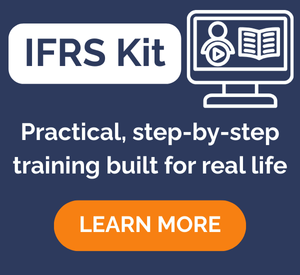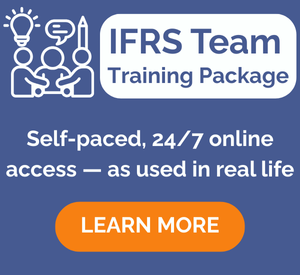Accounting for adjustments at the first-time adoption of IFRS
Question
We are working on the first-time adoption of IFRS in our company. How shall we account for the adoption adjustments?
Answer
In line with IFRS 1 First-time Adoption of International Financial Reporting Standards (par.11), all adjustments are debited or credited to opening retained earnings or in another component of equity at the transition date.
In most cases, you would debit or credit retained earnings, but there are situations when you need to recognize a separate component in equity.
For example, when you apply revaluation model to your buildings in line with IAS 16, then any excess of the fair value of buildings over their carrying amount per previous accounting rules is booked to revaluation surplus (not retained earnings).
Let me illustrate:
ABC adopts the IFRS for the first time. It has owned a lot of property, plant and equipment for a very long time and old accounting records are not available. Currently, these assets are still in use, but not recorded in the local financial statements. ABC applies cost model in line with IAS 16.
Therefore, ABC decides to apply the exemption in IFRS 1 and use fair value as deemed cost of its assets.
The fair value of the assets is CU 50 000. The first IFRS financial statements are as of 31 December 20X3.
The journal entry:
-
Debit Property, plant and equipment: CU 50 000
-
Credit Retained earnings in equity: CU 50 000
This adjustment is made on 1 January 20X2 – at the transition date. It is the beginning date of the comparative period.
Then, ABC must assess the useful life of the assets and account for depreciation in both years of 20X2 and 20X3.
Please note that here, ABC credited retained earnings and not revaluation surplus in equity. The reason is that ABC applies cost model and not revaluation model and CU 50 000 is merely recognizing the cost of assets.
You can learn more about making your IFRS financial statements here.
Tags In
JOIN OUR FREE NEWSLETTER AND GET
report "Top 7 IFRS Mistakes" + free IFRS mini-course
Please check your inbox to confirm your subscription.
3 Comments
Leave a Reply Cancel reply
Recent Comments
- Albert on Accounting for gain or loss on sale of shares classified at FVOCI
- Chris Kechagias on IFRS S1: What, How, Where, How much it costs
- atik on How to calculate deferred tax with step-by-step example (IAS 12)
- Stan on IFRS 9 Hedge accounting example: why and how to do it
- BSA on Change in the reporting period and comparatives
Categories
- Accounting Policies and Estimates (14)
- Consolidation and Groups (25)
- Current Assets (21)
- Financial Instruments (56)
- Financial Statements (54)
- Foreign Currency (9)
- IFRS Videos (74)
- Insurance (3)
- Most popular (7)
- Non-current Assets (56)
- Other Topics (15)
- Provisions and Other Liabilities (46)
- Revenue Recognition (27)
- Uncategorized (1)




Hi Silvia, we have a new company which is established in 2024 and the Jurisdiction require IFRS as a mandatory reporting framework. Do we need to apply IFRS 1 for the financial year ending 31 Dec 2024? or Should we directly apply and report under IFRS without the need to apply IFRS 1? In IFRS 1, there is a requirement to identify transition date and reconcile and adjust previous financial statements but this is not applicable to our context as the Company is preparing and issuing its first ever financial statements with no other reporting framework in the past? Thank you
I currently have an entity moving from IFRS for SMEs to IFRS and the two line items affected the most are leases and investment property. Investment property was measured at fair value and bought by a Group that measures their investment property at cost model. Two questions a. does this constitute a change in accounting policy? and what will the impact on my numbers be? also in terms of IFRS 16 do lessors show an operating lease receivable and operating lease payable? Thanks GT
Well, moving from IFRS for SMEs to full IFRS is by definition in IFRS 1 the first-time adoption of IFRS, so you should treat the change from FV model to cost model on your investment property as the first-time adopotion of IFRS (retrospectively). As for IFRS 16, no – lessors do not show receivables/payables from operating lease, they keep recognizing the asset in question.